The Egyptian eRevolution and the Role of Social Networking
0Egyptians never expect that the day will come and the people will breathe the fresh air of real freedom after the 30 years of the ex-regime that governed the country with iron and fire. Many thought it was eternal sorrow like the old Pharaohs eras, but even the Pharaohs era came to an end.
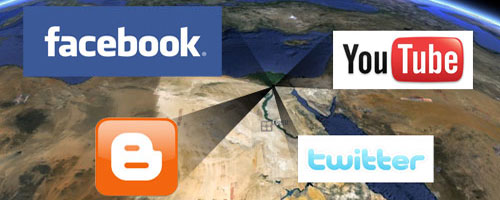
No one could ever expect that the highly restricted regime that monitored every wave of change for 30 years will fall down after 18 days with simple Facebook page and Twitter status help. Allow me to skip the story of the rotted regime since our main concern here is the technology and how the Egyptian revolution added to our technical dictionary the term “eRevolution”, this form of revolutions that initiated through social networks, fueled and monitored with the Cloud computing applications such as Facebook.
As white knights, the cloud computing trends have provided the Egyptian young people the ability to express themselves through blogs, social network sites like Facebook and Twitter and social media sites such as Youtube. Although the ex-regime had special teams and forces to monitor these activities on the web, track it and even block it in the first days of the revolution, this didn’t stop the web activists from jumping from a proxy site to another to plan and organize there for the movement.
Although I did not get the chance to take part of this revolution physically in planning and organization, I have monitored its development as an Egyptian and see how important the role of the Internet and social networks were in its success especially in the first waves. However, I will try to analyze this important role based on the revolution steps and these sites role in each step.
The eRevolution Tools

Image from Google Maps
Under the ex-regime’s restrictions, newspapers, physical meetings and phone calls were not an option to build a revolution. However, the activists have to find other ways to break the code of this system and the solution was in the new media and trends such as the social network and cloud computing applications that allowed the spreading of ideas and shared knowledge with cyber community that became initiation for physical movement.
However, the Egyptian activists depend on the following tools to spread their ideas and manage the revolution:
It is the primary tool for the revolution that converted it to a real eRevolution. The Facebook role was essential through the demonstration process in planning, providing news and getting updates.
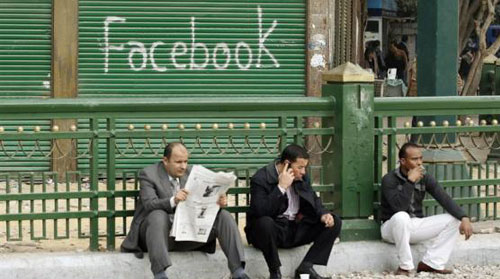
Image from Reuters (by Dylan Martinez).
Blogs
In the time where there is no real press freedom, professional and amateur writers only have the web and blogs to let their words get heard. Blogs give everyone on the web a way to share thoughts and ideas in a personalized way which sounds like a good tool for activists to spread their ideas.
While the protesters were in the streets moving from Cairo areas, Twitter was the best method to send direct status and updates about the current situation.
Youtube
As a video sharing application, demonstrators were able to document the events and share it with the world through video proofs and evidence about what is really happening out there. Although the press was covering the events in depth, the people’s video contribution showed us events that could not be covered by the press reporters.
The Initiation Stage
Although the Egyptian protests started on January 25th, the real movement started way before that when a policeman tortured a young man called Khalid Saed and the people around Egypt created a Facebook page to reflect their anger to this case.
At this point, people of Egypt especially the young generation started to see the Facebook as a way to express their feelings and opinions toward the current political situation of the country. This Fan page turned to the source for the idea behind the protests and encouraged the people to go into the streets and say no to the rotted regime.
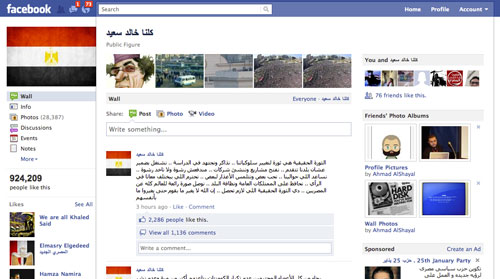
Khalid Saed page on Facebook includes more than 900,000 fans and rising. This page initiated the idea of starting a peaceful revolution from Facebook.
After the Tunisian revolution kicked the corrupted regime, the Facebook activists initiated the idea of general protests all over Egypt on January 25th. Although the page had more than 900,000 fans, it was not expected for a large impact. The protesters replied to the protest call through Facebook, Twitter and mobile text messages and it was not expected that the few thousand demonstrations turned into millions especially with the aggressive reactions for the police and government.
At this initial stage, the revolution was just ideas, status and comments on Facebook. No one could ever imagine that these few updates can have this impact even the government departments that used to monitor the internet usage and the web activities.
The Planning
It seems like skilled activists have joined the web activities at this stage merging between the old experience with the routine and digital up-to-date methods. The web activists started to arrange the protests and movements based on a previous experience with the police formations and techniques. For example, the protesters have divided the protests into small protests that communicated together through cell phones, Facebook and Twitter. Each one of these mini-protests moves through the narrow streets in the poor areas in Cairo. The frustrated people and the narrow streets can provide a good coverage to the protesters against the police large formations.
Each of these mini-protests moved toward the large gathering points and moved to the Tahreer Square where most of the government ministries and parliament are located.
Twitter and Facebook have played an important role Egypt at this stage because they were the tools to communicate with all these protests not only in Cairo but in all the Egyptian cities. Direct Tweets and Facebook page were updated frequently with the new plan and encourage people through sharing photos, videos and national songs about war and victory.
The Facebook comments worked as a support system where individuals can ask questions, add their feedback and suggestion about the day of Anger which was January 25th of 2011.
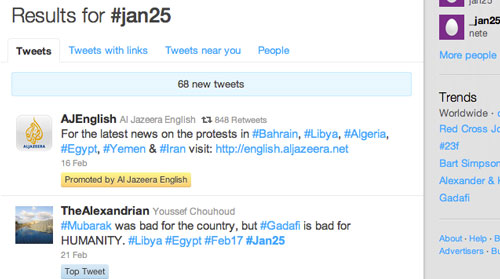
#jan25 and #egypt were the main hashes to follow the Egyptian revolution updates.
In Twitter, the hashes #Egypt and #Jan25 were assigned to show the latest updates and plans for the demonstrations where every one can search for it.
The Day of Anger
In January 25th, the plan turned from a Facebook status to a really movement in the streets. The few thousands of the Facebook fans were just the start. The web community announced the message to everyone in Egypt, even to people who never used computers like old people and poor women. It was totally a surprise for everyone including the revolution initiators. In a couple of days, the revolution turned to millions of people in the street seeking one demand; they all want the corrupted regime to step out.
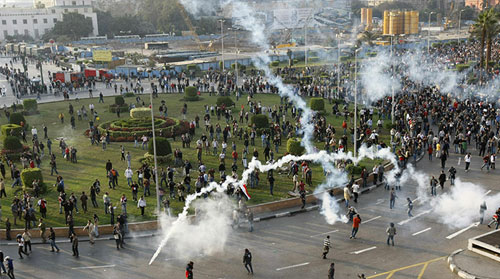
The impact of the young people’s Facebook calls on the streets of Tahreer sqaure in the center of Cairo (image from Guardian, Photograph: Mohammed Abed/AFP/Getty Images).
At this stage, status updates and tweets played a very important role to reveal the police formations and plans. Everyone knows how the police move and what they can do to reroute their mini-protests through traps and reach the final destination.
During this stage, the protesters asked every home in Egypt to unlock their wireless connections to provide Internet coverage during the protests especially when the mobile connections were very bad.
When the government could not face the frequent updates and this amazing plan that covered all Egypt minute by minute, they blocked Facebook and Twitter all over the country. This was the start to block the whole Internet service from the country as well as mobile connections. That step aimed to block the protests in small groups and prevent it from gathering in large protests because it cannot be controlled by the police forces.
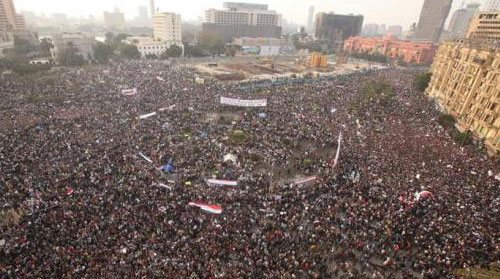
For the first time in history, one virtual event on Facebook and Twitter turned to millions of protestors all over Egypt(Image from Reuters, Suhaib Salem).
While Facebook and Twitter were blocked, protesters accessed them from proxy sites that allowed anonymous surfing through the internet.
Blocking the Internet was an expected action since the whole nation knows now that the protests are being controlled through the cyber space. Protesters in each area put a prior plan where they know what to do when they are blocked. Facebook official announced that they encountered sudden obvious decrease in the traffic from Egypt and the updates were limited to the activists from outside Egypt.
Protecting the Protestors Through Media
We all know Youtube as a video sharing social site, but the Egyptian revolution twisted its role to be a protection tool that document what happened to the protesters even after blocking the Internet. People kept recording what they see and how the brutal regime reacts with the protesters. Even so, the Internet connection was blocked from the country for the most important days where the events were on the edge, the protesters documented these events through mobile videos and photos that uploaded later to reveal what was behind this blocked moment.
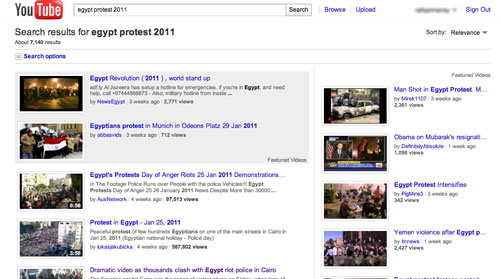
More than 7000 videos to document the Egyptian revolution from all over the country
While the world press agencies were covering the events, the Youtube videos showed the situation from a more personal view where people recorded the brutality against demonstrations from home windows without any video knowledge. They recorded the actual happening while they are seeing it. The Youtube videos were very personal and this what gives it its special effect.
Celebrations
The president stepped down on Thursday night and the country live this night in celebrations in every street around Egypt. It was obvious to not see a single Facebook status or a Twitter message at this moment, every one were celebrating!
Next morning, the Facebook shares and tweets take another trend from the aggressive content against the regime to celebrations videos and photos about the happily unsleeping Egypt.
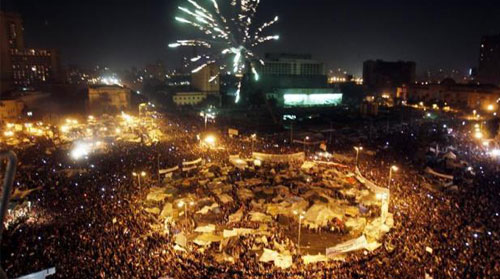
Celebrating the revolution vectory took place on the streets and the web on the same time.
The Next Step
The social technologies continued its role after the revolution. Old thinkers and politicians trusted on the social media as a way to change and deliver idea more than before.
Many people depended on Facebook to organize social works and activities such as cleaning the streets after the revolution messed up with most of the country cities. The new Facebook groups take the trend of building new Egypt and think in a new way and how to develop the country and protect the revolution from the 3rd party groups or individuals that would like to take advantage of it.
At this stage, individuals use Facebook as a cyber method to protect their revolution and keep monitoring any threats and spread the word. As a tool, Facebook helped the people to create a shield for the revolution.
The 7,000 years old army of Egypt realized the importance of cyber world and started to create its own Facebook page to address the nation with new announcements and get suggestions and feedback in the this critical stage in the country history. The page that reached 500,000 fans in few days can tell you how the people are having good intentions in this organization and how keen they are on this organization and how much they respect it.
Conclusion
The Egyptian model for the eRevolution represents a significant change in the culture behind social networks and how to extend its role to nation’s liberty and struggle against the dictator regimes. The Egyptian revolution taught us how powerful the nations are, how they can defend their rights and liberty by all means, and how the technology is carving its way in the human civilization, not only by creating new devices and providing new services, but also by affecting the existing cultures and people lives. Now, Egyptian eRevolution and the role of technology will never be forgotten; it’s now history.




